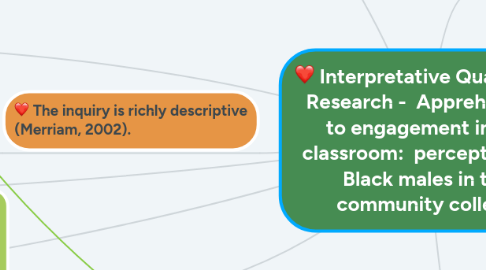Interpretative Qualitative Research - Apprehension to engagement in the classroom: perceptions of Black males in the community college
by LaKrista Page

1. Clearly this study added to body of literature to understand the apprehension of Black males in two year institution. There is a correlation between social, cultural, generational and psychological constructs which the researcher introduce. This correlates the many descriptions of discord from the participants reported.
2. Research participant responses gave light to similar attitudes and experiences. While many of the Black males responded and might have been labeled as introverted, many never reached out to faculty or their classmates for help or support. Their response were they felt dumb or stupid and that was why they never asked for help.
3. References Bryman, A. (2004), Social research methods (2nd ed.) Oxford, NY; Oxford University Press. Merriam, S.B. (2002). Qualitative research in practice. San Francisco, CA; Jossey-Bass. Wood, J.L. (2014). Apprehension to engagement in the classroom: Perceptions of Black males in the community college. International Journal of Qualitative Studies in Education 27(6), 785-801.
4. The process is inductive (Merriam, 2002).
4.1. “Interviews were coded for themes and analyzed using the systematic data analysis technique outlined by Miles and Huberman” (Wood, 2014, p. 791). “This approach requires the researcher to develop questions, identify a theoretical framework or create a conceptual lens, pre-hypothesize odes, and determine the method of analysis prior to data collection” ” (Wood, 2014, p. 791).
4.2. *The researcher utilized convenient and snowball method of collecting data from the population. This process delivered a rich population of participants as well as a deliberate cross reference mapping method to canvas the campus.
5. The inquiry is richly descriptive (Merriam, 2002).
5.1. “When students did provide a rationale for apprehensive actions there were strikingly similar. Participants comments illustrated that faculty members and other students perceived them as academically inferior…’dumb,’ ‘ignorant,’ and ‘stupid’” (Wood, 2014, p. 792).
6. The researcher strives to make meaning (Merriam, 2002).
6.1. "This study is significant as it lends additional insight into the experiences of Black males at community colleges. There is a reason to believe that the lives of Black males within this institutional type are unique" (Wood, 2014, p. 786).
7. Seeing through the eyes of the people being studied (Bryman, 2004).
7.1. “…insights provide a unique lens into the educational perceptions, experiences, challenges, and triumphs of Black males” (Wood, 2014, p.785).
7.2. This research helps to make sense of the stereotypical behaviors of Black males in academia, more importantly in two year institutions. The researcher shines light on the male struggle to ask for help in academic settings therefore adding undue stress to their plight for education.
8. The researcher is the primary instrument for data collection (Merriam, 2002).
8.1. "Study participants were recruited through convenience and snowball sampling. Convenience sampling...allows the researcher to maximize their own social network by acquiring participants that are the most easily obtained" (Wood, 2014, p. 791).
8.2. First the plight of the study and inquiry place the researcher in a very unique position to tell the story of the academic apprehension of Black males in two year institutions. As the researcher utilized the convenience method to collect data from participant shows the impatience of this population and his need to yield information to add to this new body of literature.
9. Flexibility and Limited Structure (Bryman, 2004).
9.1. "What is known about the Black male experience in two-year colleges, especially as it relates to achievement and engagement is limited" (wood, 2014, p. 787).
9.2. This research was designed to leave open the possibility for additional and follow up questions. The researcher was able to gain the trust to listen and probe into a very personal area of the participants lives. General questions and the unstructured approach gave room for additional questions for this qualitative inquiry.


